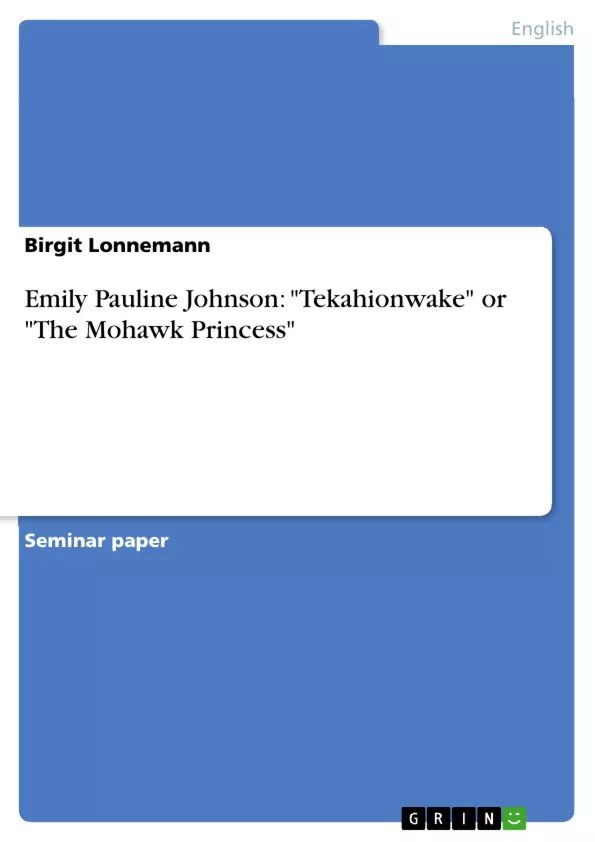“Pauline Johnson’s physical body died in 1913, but her spirit still communicates to us who are Native women writers. She walked the writing path clearing the brush for us to follow. And the road gets wider and closer each time a Native woman picks up her pen and puts her mark on paper.” (Brant & Laronde 1996: 84).
Emily Pauline Johnson seems to be the mother of all women writers of the First Nations. She is like a spiritual ancestor to all of them.
Emily Pauline Johnson – the daughter of a Native
Canadian father and an English mother – used the Mohawk
name “Tekahionwake” which she took from her greatgrandfather
Jacob Johnson. Being one of the most popular and
successful entertainers and stage performers in Canada at the
turn of the century, Johnson became known as
the “Mohawk Princess”. She was not only one of the few female
writers of her time who managed to earn their living through
writing and performing, but she was also the first Native poet in
Canada who had her work published.
I decided to divide my paper into two main parts. On the one
hand, Emily Pauline Johnson’s biography, her
youth and her family, her career and her
travels, and her identity are to be discussed. On the other hand, I will talk about Johnson’s literary work, especially about “A Pagan In St. Paul’s Cathedral” and “A Red Girl’s Reasoning”. I
will finish my paper by giving a short conclusion to the topic.
Table of Contents
- I. Introduction
- II. Emily Pauline Johnson's Biography
- II. 1. Her Youth And Her Family
- II. 2. Family Tree
- II. 3. Her Career And Her Travels
- II. 4. Her Identity
- III. Emily Pauline Johnson's Literary Work
- III. 1. “A Pagan In St. Paul's Cathedral”
- III. 2. “A Red Girl's Reasoning”
- IV. Conclusion
Objectives and Key Themes
This paper explores the life and works of Emily Pauline Johnson, a prominent Native Canadian poet and performer of the late 19th and early 20th centuries. The main objective is to provide an in-depth analysis of her biography, literary works, and particularly her exploration of Native identity in a colonial context. Key themes and ideas addressed in the paper include:- The intersection of Native and European cultures in Johnson's life and writing.
- The challenges and opportunities faced by Native women as artists and intellectuals in a colonial society.
- Johnson's use of her mixed heritage to create a unique voice and perspective.
- The role of performance and storytelling in shaping Native identity and cultural expression.
- The impact of Johnson's legacy on contemporary Native writers and artists.
Chapter Summaries
The introduction sets the stage for the paper by exploring the legacy of Emily Pauline Johnson and her significance for Native women writers. It establishes the scope of the paper, focusing on her biography and literary works, particularly "A Pagan In St. Paul's Cathedral" and "A Red Girl's Reasoning." Chapter II delves into Johnson's biography, beginning with her early life and family history. It provides detailed information about her parents, siblings, and ancestors, tracing her lineage back to the founding of the Six Nations Confederacy. The chapter also explores Johnson's upbringing on the Six Nations Reserve and the complex cultural influences she experienced. Chapter II.1 provides a more in-depth exploration of Johnson's upbringing and family dynamics, highlighting the challenges and opportunities associated with her mixed heritage. Chapter II.2 presents a family tree, offering a visual representation of Johnson's ancestry and the intricate web of relationships within her family. This visual aid clarifies the often complex family structure and allows for a deeper understanding of Johnson's heritage. Chapter II.3 examines Johnson's career as a writer, performer, and public figure. It covers her early experiences in theatre, her travels throughout Canada and the United States, and the challenges she faced as a Native woman seeking recognition in a predominantly Eurocentric world. Chapter II.4 focuses on Johnson's identity as a Native woman in a colonial society. It analyzes how she navigated the complexities of her heritage, embracing her Mohawk roots while also acknowledging her English lineage. Chapter III explores Johnson's literary works, particularly focusing on two poems, "A Pagan In St. Paul's Cathedral" and "A Red Girl's Reasoning". The chapter analyzes the themes, symbolism, and language of these poems, revealing Johnson's powerful voice and her unique perspective on Native identity and colonialism. Chapter III.1 specifically examines "A Pagan In St. Paul's Cathedral," analyzing its structure, themes, and symbolism. Chapter III.2 focuses on "A Red Girl's Reasoning," exploring the poem's narrative, its central arguments, and its significance within Johnson's body of work.Keywords
The paper focuses on key concepts and themes central to understanding Emily Pauline Johnson's life and work. These include: Native American identity, colonial literature, gender, performance, storytelling, cultural heritage, mixed heritage, and Native women writers. The analysis also incorporates key figures and texts, such as the Six Nations Confederacy, "A Pagan In St. Paul's Cathedral," and "A Red Girl's Reasoning," to provide a deeper exploration of these concepts.- Quote paper
- Dr. phil. Birgit Lonnemann (Author), 1999, Emily Pauline Johnson: "Tekahionwake" or "The Mohawk Princess", Munich, GRIN Verlag, https://www.grin.com/document/117715



